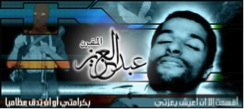
It is believed that Muslim martyrs will be highly rewarded in the afterlife for their sacrifice and that they hold a special position in heavenly paradise. It is therefore not surprising that martyrdom is a central theme in jihadi visual propaganda. The caption at the bottom of this image is a verse from a widespread poem that is very popular in conservative-mainstream Islamic circles, as well as among jihadists. It reads: “aqsamtu illa an a‘isha bi-‘izzati, bi-karamati, aw an taduqqa ‘izami(ya)” (“I swore that I would live by my honor and dignity, or my bones will be pulverized”). ‘Abd al-‘Aziz al-Muqrin, the figure in the image, was the head of al-Qa’ida in Saudi Arabia and the mastermind behind the suicide bombing of a residential housing compound in Riyadh on 8 November 2003, in which seventeen people were killed. The last operation commanded by ‘Abd al-‘Aziz was probably the 18 June 2004 beheading of the American hostage Paul Johnson. It was reported that a few hours after this operation, when ‘Abd al-‘Aziz was moving the American engineer’s body, he was killed after being surrounded by local Saudi forces. Here, he is shown against a white background of light evoking notions of death (in the state of purity), shrouds, grief and mourning. The dove above the figure signals to the viewer that ‘Abd al-‘Aziz successfully attained martyrdom. Doves in Islam are considered sacred, since a dove is believed to have protected Muhammad on his nocturnal journey. The dove is also a symbol of loving fidelity, which is manifested by its wearing a collar of dark feathers around its neck, called “the dove’s necklace.”
 Skip to content
Skip to content
